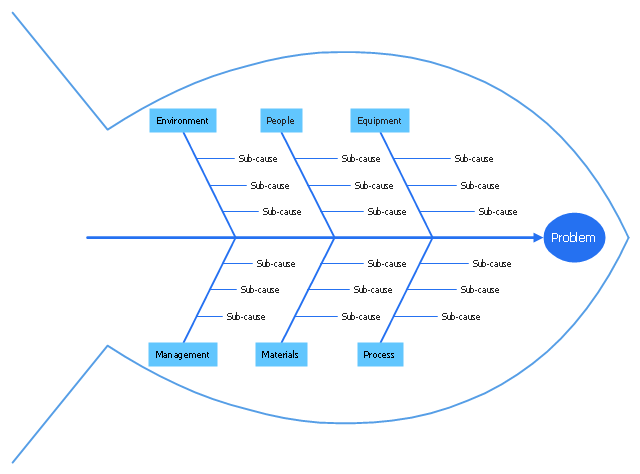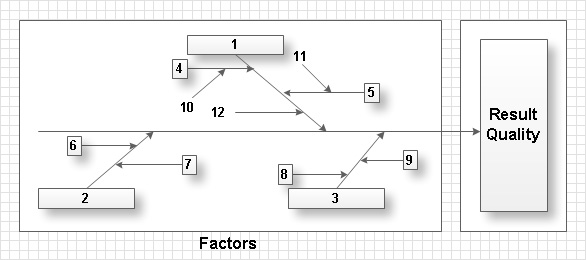"Common uses of the Ishikawa diagram are product design and quality defect prevention, to identify potential factors causing an overall effect. Each cause or reason for imperfection is a source of variation. Causes are usually grouped into major categories to identify these sources of variation. The categories typically include:
(1) People: Anyone involved with the process;
(2) Methods: How the process is performed and the specific requirements for doing it, such as policies, procedures, rules, regulations and laws;
(3) Machines: Any equipment, computers, tools, etc. required to accomplish the job;
(4) Materials: Raw materials, parts, pens, paper, etc. used to produce the final product;
(5) Measurements: Data generated from the process that are used to evaluate its quality;
(6) Environment: The conditions, such as location, time, temperature, and culture in which the process operates. ...
Ishikawa diagrams were popularized by Kaoru Ishikawa in the 1960s, who pioneered quality management processes in the Kawasaki shipyards, and in the process became one of the founding fathers of modern management.
The basic concept was first used in the 1920s, and is considered one of the seven basic tools of quality control." [Ishikawa diagram. Wikipedia]
This quality Ishikawa diagram (cause and effect diagram) template is included in the Fishbone Diagram solution from the Management area of ConceptDraw Solution Park.
(1) People: Anyone involved with the process;
(2) Methods: How the process is performed and the specific requirements for doing it, such as policies, procedures, rules, regulations and laws;
(3) Machines: Any equipment, computers, tools, etc. required to accomplish the job;
(4) Materials: Raw materials, parts, pens, paper, etc. used to produce the final product;
(5) Measurements: Data generated from the process that are used to evaluate its quality;
(6) Environment: The conditions, such as location, time, temperature, and culture in which the process operates. ...
Ishikawa diagrams were popularized by Kaoru Ishikawa in the 1960s, who pioneered quality management processes in the Kawasaki shipyards, and in the process became one of the founding fathers of modern management.
The basic concept was first used in the 1920s, and is considered one of the seven basic tools of quality control." [Ishikawa diagram. Wikipedia]
This quality Ishikawa diagram (cause and effect diagram) template is included in the Fishbone Diagram solution from the Management area of ConceptDraw Solution Park.
Total Quality Management with ConceptDraw
Total Quality Management (TQM) system is the management method where the confidence in quality of all organization processes is placed foremost. The given method is widely used in production, in educational system, in government organizations and so on.
 Fishbone Diagram
Fishbone Diagram
Fishbone Diagrams solution extends ConceptDraw PRO software with templates, samples and library of vector stencils for drawing the Ishikawa diagrams for cause and effect analysis.
 Fishbone Diagrams
Fishbone Diagrams
The Fishbone Diagrams solution extends ConceptDraw PRO v10 software with the ability to easily draw the Fishbone Diagrams (Ishikawa Diagrams) to clearly see the cause and effect analysis and also problem solving. The vector graphic diagrams produced using this solution can be used in whitepapers, presentations, datasheets, posters, and published technical material.
 Circle-Spoke Diagrams
Circle-Spoke Diagrams
Examples of subject areas that are well suited to this approach are marketing, business, products promotion, process modeling, market, resource, time, and cost analysis. Circle-Spoke Diagrams are successfully used in presentations, conferences, management documents, magazines, reportages, reviews, reports, TV, and social media.
- Fishbone Diagram | Quality fishbone diagram template | Fishbone ...
- Fishbone Diagram | Seven Basic Tools of Quality - Fishbone ...
- Manufacturing 8 Ms fishbone diagram - Template | Total Quality ...
- Fishbone Diagram | Business Productivity Diagramming | Quality ...
- Service 8 Ps fishbone diagram - Template | Management | Quality ...
- Using Fishbone Diagrams for Problem Solving | Cause and Effect ...
- Total Quality Management Value | TQM Diagram Tool | Quality ...
- Cause and Effect Analysis ( Fishbone Diagrams ) | Seven Basic Tools ...
- Cause and Effect Analysis ( Fishbone Diagrams ) | Quality fishbone ...
- Total Quality Management Value | Manufacturing 8 Ms fishbone ...
- Workflow Diagram Template
- Manufacturing 8 Ms fishbone diagram template | Fishbone diagram ...
- Fishbone diagram - Causes of low- quality output | Design elements ...
- Total Quality Management Value | Fishbone Diagram | Seven Basic ...
- Manufacturing 8 Ms fishbone diagram - Template
- Total Quality Management with ConceptDraw | TQM Diagram Tool ...
- Total Quality Management Value | TQM Diagram Tool | Design ...
- Quality fishbone diagram - Template | Cause and Effect Diagrams ...
- Business Productivity Diagramming | Ishikawa Diagram | Total ...
- Manufacturing 8 Ms fishbone diagram - Template | Ishikawa ...

